Investigation on the Coupling Coordination Relationship between Electric Power Green Development and Ecological Civilization Construction in China: A Case Study of Beijing
Abstract
:1. Introduction
2. Evaluation Index System of EPGD and ECC
2.1. Main Elements of EPGD and ECC
2.1.1. Main Elements of EPGD
- Power generation side: This part includes cleanliness of power generation and power generation equipment utilization efficiency. The cleanliness of power generation includes cleanliness of power generation structure and cleanliness of thermal power.
- Grid side: This part includes grid transmission efficiency and harmony between the power grid and the urban landscape. Among them, the grid transmission efficiency is embodied in the energy saving in the power transmission process and the power transmission line utilization efficiency.
- User side: This part includes the contribution of electricity to production and living and the efficiency of industrial electricity consumption. The contribution of electricity to production and living is to reflect the importance of electricity as an energy source in production and life. The efficiency of industrial electricity consumption is to reflect the efficiency of electricity consumption. The contribution of electricity to production and living is reflected in the electricity proportion in energy consumption of terminal, and the electricity consumption of people’s lives.
2.1.2. Main Elements of ECC
- Resources: This part includes efficient utilization and adequate reserves of resources. It is mainly reflected by the level of resource consumption and the level of resource retention.
- Environment: This part includes environmental pollution and governance level. That is to maintain a good environmental condition by reducing the emission of various forms of pollutants and increasing the investment of environmental protection.
- Economy: This part includes economic growth and production efficiency. Economic growth reflects the results of industrial development, and production efficiency measures the process of industrial development. Specifically, it includes the increase of the overall output value, the industrial structure optimization, and the production efficiency improvement of various industries.
- Society: This part refers to the happiness of people’s lives mainly. On the one hand, it is reflected in the material standard of living, including the levels of income and consumption; on the other hand, it is reflected in the physical and mental health, including the living environment and health status.
2.2. Construction of Index System
2.3. Explanation of the Index System
2.3.1. Index System of EPGD
- On the power generation side, the cleanliness of the power generation structure is measured by G11–G13, where clean energy refers to power generation from energy sources other than thermal power; the thermal power cleanliness is measured by G14; the utilization efficiency of power generation equipment is measured by G15. In particular, in the cross-regional transmission of power, the pollution caused by power production will be detrimental to the environment in the power output area, but it will not affect the environment in the power input area. So, the proportion of external power received can reflect the cleanliness of the power generation of the power input area to a certain extent.
- On the grid side, energy saving in the transmission process, the utilization efficiency of transmission lines, and harmony between the power grid and urban landscape are measured by G21, G22, and G23, respectively. Among them, laying power lines underground can reduce the occupation of land and space by overhead lines, which is conducive to improving the aesthetics of urban landscapes. At the same time, it is protected from adverse weather conditions and has a relatively low failure rate, which is conducive to improving the reliability of power transmission.
- On the user side, the degree of electric power substitution is measured by G31; the electricity consumption of people’s lives is measured by G32; the efficiency of industrial electricity consumption is measured by G33–G35.
2.3.2. Index System of ECC
- In terms of resources, resource consumption is measured by E11 and E12; resource retention is measured by E13 and E14.
- In terms of environment, gas waste, liquid water and solid waste pollution are measured by E21–E25, respectively; environmental protection investment is measured by E26.
- In terms of economy, the increase of output value is measured by E31; the industrial structure optimization is measured by E32; the production efficiency of the three industries is measured by E33–E35. In particular, the relationship between the tertiary industry and consumption is the most direct, and consumption is a reliable force for sustained economic growth. Therefore, the proportion of the added value of the tertiary industry is used to measure the effect on the economic growth of the optimization of industrial structure.
- In terms of society, income and consumption are measured by E41–E43; living environment and health are measured by E44 and E45.
3. Research Methods
3.1. Coupling Coordination Degree Model
3.1.1. Data Pre-Processing
3.1.2. Improved AHP Based on Cloud Model for Weight Determination
Basic Concept of the Cloud Model
3.1.3. Evaluation of EPGD and ECC
3.1.4. Evaluation of the CCD
3.2. Regression Model
3.3. Research Framework
4. Case Study
4.1. Study Area and Data Sources
4.2. Results and Discussion
4.2.1. Analysis of the Important Factors Based on Weight
4.2.2. Analysis of the CCD between the EPGD and the ECC
Comprehensive Evaluation of EPGD
Comprehensive Evaluation of ECC
Performance of CCD Between EPGD and ECC
- 1.
- 2004–2006: the two subsystems were in the “slightly unbalanced” stage. At this stage, the comprehensive level of EPGD was higher than the comprehensive level of ECC, so the two subsystems were in a slightly unbalanced phase with lagging ECC.
- 2.
- 2007–2015: the two subsystems entered the “barely balanced” stage. From 2007 to 2012, the comprehensive level of EPGD was greater than that of ECC, so the two subsystems were in a barely balanced stage with lagging ECC. From 2013 to 2015, the comprehensive level of ECC was greater than that of EPGD. So, the two subsystems were in a barely balanced stage with lagging EPGD.
- 3.
- 2016–2017: The two subsystems achieved the “highly balanced” status. At this stage, the comprehensive level of ECC was greater than that of EPGD, so the two subsystems were in a highly balanced phase with lagging EPGD.
4.2.3. Analysis of the Important Factors According to the Regression Analysis
Impact of First-Class Indicators of EPGD on ECC
The Influence of the First-Class Index of ECC on EPGD
4.3. Policy Suggestion
4.3.1. Suggestions on Promoting EPGD
4.3.2. Suggestions on Promoting ECC
5. Conclusions
Author Contributions
Funding
Acknowledgments
Conflicts of Interest
References
- Zhang, L.; Yang, J.; Li, D.; Liu, H.; Xie, Y.; Song, T.; Luo, S. Evaluation of the ecological civilization index of China based on the double benchmark progressive method. J. Clean. Prod. 2019, 222, 511–519. [Google Scholar] [CrossRef]
- Chang, I.-S.; Wang, W.; Wu, J. To strengthen the practice of ecological civilization in China. Sustainability 2019, 11, 4661. [Google Scholar] [CrossRef] [Green Version]
- Wang, X.; Chen, X. An Evaluation index system of China’s development level of ecological civilization. Sustainability 2019, 11, 2270. [Google Scholar] [CrossRef] [Green Version]
- Liu, C.; Chen, L.; Vanderbeck, R.M.; Valentine, G.; Zhang, M.; Diprose, K.; McQuaid, K. A Chinese route to sustainability: Postsocialist transitions and the construction of ecological civilization. Sustain. Dev. 2018, 26, 741–748. [Google Scholar] [CrossRef]
- Jiang, B.; Bai, Y.; Wong, C.P.; Xu, X.; Alatalo, J.M. China’s ecological civilization program–Implementing ecological redline policy. Land Use Policy 2019, 81, 111–114. [Google Scholar] [CrossRef]
- Lai, X.; Liu, G.; Wang, H. Evaluation and analysis of DEA efficiency in construction of ecological civilization of Jiangsu province. Disaster Adv. 2013, 6, 102–108. [Google Scholar]
- Liu, M.; Liu, X.; Yang, Z. An integrated indicator on regional ecological civilization construction in China. Int. J. Sustain. Dev. World Ecol. 2016, 23, 53–60. [Google Scholar] [CrossRef]
- Zhang, X.; Wang, Y.; Qi, Y.; Wu, J.; Liao, W.; Shui, W.; Zhang, Y.; Deng, S.; Peng, H.; Yu, X.; et al. Evaluating the trends of China’s ecological civilization construction using a novel indicator system. J. Clean. Prod. 2016, 133, 910–923. [Google Scholar] [CrossRef]
- Zhao, Y. Evaluation of ecological civilization in megacities. Appl. Ecol. Environ. Res. 2019, 17, 8527–8540. [Google Scholar] [CrossRef]
- Yang, P. Evaluation of ecological civilization development in the post-Olympic times. Appl. Ecol. Environ. Res. 2019, 17, 8513–8525. [Google Scholar] [CrossRef]
- Chen, J.; Cheng, J.; Dai, S. Regional eco-innovation in China: An analysis of eco-innovation levels and influencing factors. J. Clean. Prod. 2017, 153, 1–14. [Google Scholar] [CrossRef]
- National Energy Administration. Suzhou Consensus. Available online: http://www.nea.gov.cn/2016-10/31/c_135794708.htm (accessed on 15 September 2020).
- Wu, H.; Li, Y.; Hao, Y.; Ren, S.; Zhang, P. Environmental decentralization, local government competition, and regional green development: Evidence from China. Sci. Total Environ. 2020, 708, 135085. [Google Scholar] [CrossRef]
- Zhu, N.; Bu, Y.; Jin, M.; Mbroh, N. Green financial behavior and green development strategy of Chinese power companies in the context of carbon tax. J. Clean. Prod. 2020, 245, 118908. [Google Scholar] [CrossRef]
- Mundaca, L.; Markandya, A. Assessing regional progress towards a ‘Green Energy Economy’. Appl. Energy 2016, 179, 1372–1394. [Google Scholar] [CrossRef]
- Reddy, B.S. India’s energy system transition-Survival of the greenest. Renew. Energy 2016, 92, 293–302. [Google Scholar] [CrossRef]
- Peterson, T.R.; Stephens, J.C.; Wilson, E.J. Public perception of and engagement with emerging low-carbon energy technologies: A literature review. MRS Energy Sustain. 2015, 2. [Google Scholar] [CrossRef] [Green Version]
- Xu, B.; Zhou, S.; Hao, L. Approach and practices of district energy planning to achieve low carbon outcomes in China. Energy Policy 2015, 83, 109–122. [Google Scholar] [CrossRef]
- Bilgen, S.; Sarikaya, I. The use and its impact on the environment of cogeneration as an important element for a clean and sustainable energy future. Energy Sources Part Recovery Util. Environ. Eff. 2017, 39, 2078–2086. [Google Scholar] [CrossRef]
- Ma, Y.; Yan, J.; Sha, J.; He, G.; Song, C.; Fan, S.; Ke, W. Dynamic simulation of the atmospheric environment improved by a focus on clean energy utilization of resource-based cities in China. J. Clean. Prod. 2018, 192, 396–410. [Google Scholar] [CrossRef]
- Zhao, Y.; Cui, Z.; Wu, L.; Gao, W. The green behavioral effect of clean coal technology on China’s power generation industry. Sci. Total Environ. 2019, 675, 286–294. [Google Scholar] [CrossRef]
- Akyuz, E.; Kaynak, B. Use of dispersion model and satellite SO2 retrievals for environmental impact assessment of coal-fired power plants. Sci. Total Environ. 2019, 689, 808–819. [Google Scholar] [CrossRef] [PubMed]
- Chen, X.; Liu, Q.; Sheng, T.; Li, F.; Xu, Z.; Han, D.; Zhang, X.; Huang, X.; Fu, Q.; Cheng, J. A high temporal-spatial emission inventory and updated emission factors for coal-fired power plants in Shanghai, China. Sci. Total Environ. 2019, 688, 94–102. [Google Scholar] [CrossRef] [PubMed]
- Contini, D.; Cesari, D.; Conte, M.; Donateo, A. Application of PMF and CMB receptor models for the evaluation of the contribution of a large coal-fired power plant to PM10 concentrations. Sci. Total Environ. 2016, 560–561, 131–140. [Google Scholar] [CrossRef]
- Minichilli, F.; Gorini, F.; Bustaffa, E.; Cori, L.; Bianchi, F. Mortality and hospitalization associated to emissions of a coal power plant: A population-based cohort study. Sci. Total Environ. 2019, 694, 133757. [Google Scholar] [CrossRef]
- Noli, F.; Tsamos, P. Concentration of heavy metals and trace elements in soils, waters and vegetables and assessment of health risk in the vicinity of a lignite-fired power plant. Sci. Total Environ. 2016, 563–564, 377–385. [Google Scholar] [CrossRef]
- Peters, D.; Axsen, J.; Mallett, A. The role of environmental framing in socio-political acceptance of smart grid: The case of British Columbia, Canada. Renew. Sustain. Energy Rev. 2018, 82, 1939–1951. [Google Scholar] [CrossRef]
- Wu, J.; Tan, Z.; De, G.; Pu, L.; Wang, K.; Tan, Q.; Ju, L. Multiple scenarios forecast of electric power substitution potential in China: From perspective of green and sustainable development. Processes 2019, 7, 584. [Google Scholar] [CrossRef] [Green Version]
- Ren, J.; Dong, L. Evaluation of electricity supply sustainability and security: Multi-criteria decision analysis approach. J. Clean. Prod. 2018, 172, 438–453. [Google Scholar] [CrossRef]
- Botelho, A.; Pinto, L.M.C.; Lourenço-Gomes, L.; Valente, M.; Sousa, S. Social sustainability of renewable energy sources in electricity production: An application of the contingent valuation method. Sustain. Cities Soc. 2016, 26, 429–437. [Google Scholar] [CrossRef]
- Atilgan, B.; Azapagic, A. An integrated life cycle sustainability assessment of electricity generation in Turkey. Energy Policy 2016, 93, 168–186. [Google Scholar] [CrossRef]
- San Miguel, G.; Cerrato, M. Life cycle sustainability assessment of the Spanish electricity: Past, present and future projections. Energies 2020, 13, 1896. [Google Scholar] [CrossRef] [Green Version]
- Liu, N.; Liu, C.; Xia, Y.; Da, B. Examining the coordination between urbanization and eco-environment using coupling and spatial analyses: A case study in China. Ecol. Indic. 2018, 93, 1163–1175. [Google Scholar] [CrossRef]
- Li, Y.; Li, Y.; Zhou, Y.; Shi, Y.; Zhu, X. Investigation of a coupling model of coordination between urbanization and the environment. J. Environ. Manag. 2012, 98, 127–133. [Google Scholar] [CrossRef]
- Xing, L.; Xue, M.; Hu, M. Dynamic simulation and assessment of the coupling coordination degree of the economy–resource–environment system: Case of Wuhan City in China. J. Environ. Manag. 2019, 230, 474–487. [Google Scholar] [CrossRef]
- Cui, D.; Chen, X.; Xue, Y.; Li, R.; Zeng, W. An integrated approach to investigate the relationship of coupling coordination between social economy and water environment on urban scale—A case study of Kunming. J. Environ. Manag. 2019, 234, 189–199. [Google Scholar] [CrossRef]
- Liu, W.; Jiao, F.; Ren, L.; Xu, X.; Wang, J.; Wang, X. Coupling coordination relationship between urbanization and atmospheric environment security in Jinan City. J. Clean. Prod. 2018, 204, 1–11. [Google Scholar] [CrossRef]
- Wang, H.; Feng, Y. Improved AHP based on judgment matrix scaled with cloud model. Chin. J. Manag. Sci. 2005, 13, 32–37. [Google Scholar]
- Li, H.; Mu, H.; Gui, S.; Li, M. Scenario analysis for optimal allocation of China’s electricity production system. Sustain. Cities Soc. 2014, 10, 241–244. [Google Scholar] [CrossRef]
- Noorollahi, Y.; Itoi, R.; Yousefi, H.; Mohammadi, M.; Farhadi, A. Modeling for diversifying electricity supply by maximizing renewable energy use in Ebino city southern Japan. Sustain. Cities Soc. 2017, 34, 371–384. [Google Scholar] [CrossRef]
- Zhang, L.; Zhao, Z.; Xin, H.; Chai, J.; Wang, G. Charge pricing model for electric vehicle charging infrastructure public-private partnership projects in China: A system dynamics analysis. J. Clean. Prod. 2018, 199, 321–333. [Google Scholar] [CrossRef]
- Deveci, M.; Pekaslan, D.; Canıtez, F. The assessment of smart city projects using zSlice type-2 fuzzy sets based Interval Agreement Method. Sustain. Cities Soc. 2020, 53, 101889. [Google Scholar] [CrossRef]
- Sharifi, A. A typology of smart city assessment tools and indicator sets. Sustain. Cities Soc. 2020, 53, 101936. [Google Scholar] [CrossRef]
- Zhou, D.; Xu, J.; Lin, Z. Conflict or coordination? Assessing land use multi-functionalization using production-living-ecology analysis. Sci. Total Environ. 2017, 577, 136–147. [Google Scholar] [CrossRef] [PubMed]
- Zhou, S.; Yang, L.; Gao, R.; Wang, X.; Gao, X.; Nie, W.; Xu, P.; Zhang, Q.; Wang, W. A comparison study of carbonaceous aerosols in a typical North China Plain urban atmosphere: Seasonal variability, sources and implications to haze formation. Atmos. Environ. 2017, 149, 95–103. [Google Scholar] [CrossRef]
- Zhou, Z.X.; Li, J.; Zhang, W. Coupled urbanization and agricultural ecosystem services in Guanzhong-Tianshui Economic Zone. Environ. Sci. Pollut. Res. 2016, 23, 15407–15417. [Google Scholar] [CrossRef] [PubMed]
- Wang, Q.; Yuan, X.; Cheng, X.; Mu, R.; Zuo, J. Coordinated development of energy, economy and environment subsystems-A case study. Ecol. Indic. 2014, 46, 514–523. [Google Scholar] [CrossRef]
- Yan, Q.; Zhang, M.; Li, W.; Qin, G. Risk assessment of new energy vehicle supply chain based on variable weight theory and cloud model: A case study in China. Sustainability 2020, 12, 3150. [Google Scholar] [CrossRef] [Green Version]
- Li, D.; Liu, C.; Gan, W. A new cognitive model: Cloud model. Int. J. Intell. Syst. 2009, 24, 357–375. [Google Scholar] [CrossRef]
- Zhang, L.; Xin, H.; Kan, Z. Sustainability performance evaluation of hybrid energy system using an improved fuzzy synthetic evaluation approach. Sustainability 2019, 11, 1265. [Google Scholar] [CrossRef] [Green Version]
- Zhang, L.; Xin, H.; Yong, H.; Kan, Z. Renewable energy project performance evaluation using a hybrid multi-criteria decision-making approach: Case study in Fujian, China. J. Clean. Prod. 2019, 206, 1123–1137. [Google Scholar] [CrossRef]
- Wu, G.; Duan, K.; Zuo, J.; Zhao, X.; Tang, D. Integrated sustainability assessment of public rental housing community based on a hybrid method of AHP-Entropy weight and cloud model. Sustainability 2017, 9, 603. [Google Scholar] [CrossRef] [Green Version]
- Ai, J.; Feng, L.; Dong, X.; Zhu, X.; Li, Y. Exploring coupling coordination between urbanization and ecosystem quality (1985–2010): A case study from Lianyungang City, China. Front. Earth Sci. 2016, 10, 527–545. [Google Scholar] [CrossRef]
- Tang, Z. An integrated approach to evaluating the coupling coordination between tourism and the environment. Tour. Manag. 2015, 46, 11–19. [Google Scholar] [CrossRef]
- Huang, J.; Li, Q.; Pontius, R.G.; Klemas, V.; Hong, H. Detecting the dynamic linkage between landscape characteristics and water quality in a subtropical coastal watershed, Southeast China. Environ. Manag. 2013, 51, 32–44. [Google Scholar] [CrossRef]
- Niu, D.; Song, Z.; Xiao, X. Electric power substitution for coal in China: Status quo and SWOT analysis. Renew. Sustain. Energy Rev. 2017, 70, 610–622. [Google Scholar] [CrossRef]
- Rahman, M.M.; Karunasinghe, J.; Clifford, S.; Knibbs, L.D.; Morawska, L. New insights into the spatial distribution of particle number concentrations by applying non-parametric land use regression modelling. Sci. Total Environ. 2020, 702, 134708. [Google Scholar] [CrossRef]
- Beijing Municipal Bureau Statistics. Beijing Statistical Yearbook. Available online: http://tjj.beijing.gov.cn/tjsj_31433/ (accessed on 15 September 2020).
- National Bureau of Statistics. China Electric Power Yearbook. Available online: https://data.cnki.net/yearbook/Single/N2019060101 (accessed on 15 September 2020).
- National Bureau of Statistics. China Energy Statistical Yearbook. Available online: https://data.cnki.net/yearbook/Single/N2019080025 (accessed on 15 September 2020).
- Hu, J. Party’s Seventeenth Congress Report. Available online: http://cpc.people.com.cn/GB/64162/64168/106155/106156/6430009.html (accessed on 15 September 2020).
- The People’s Government of Beijing Municipality. Opinions on Comprehensively Promoting the Construction of a Water-Saving Society. Available online: http://www.beijing.gov.cn/zhengce/zhengcefagui/201905/t20190522_59043.html (accessed on 15 September 2020).
- Beijing Gardening and Greening Bureau. Master Plan for a New Round of One Million Mu Afforestation Project. Available online: http://yllhj.beijing.gov.cn/zwgk/ (accessed on 15 September 2020).
- Beijing Municipal Commission of Development and Reform. The key Points of Energy Work of Beijing in 2018. Available online: http://fgw.beijing.gov.cn/gzdt/tztg/202004/t20200417_1818984.htm (accessed on 15 September 2020).

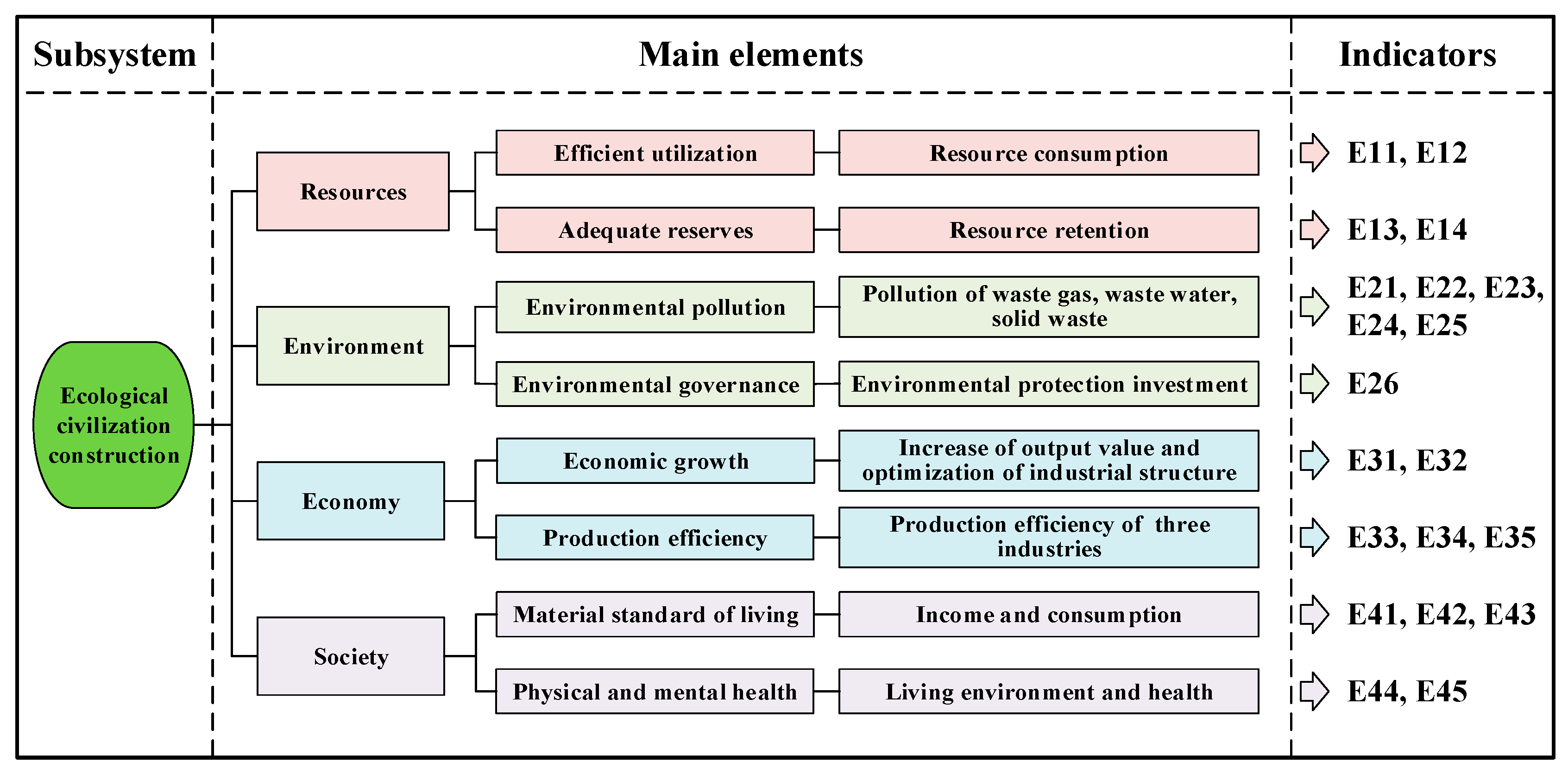




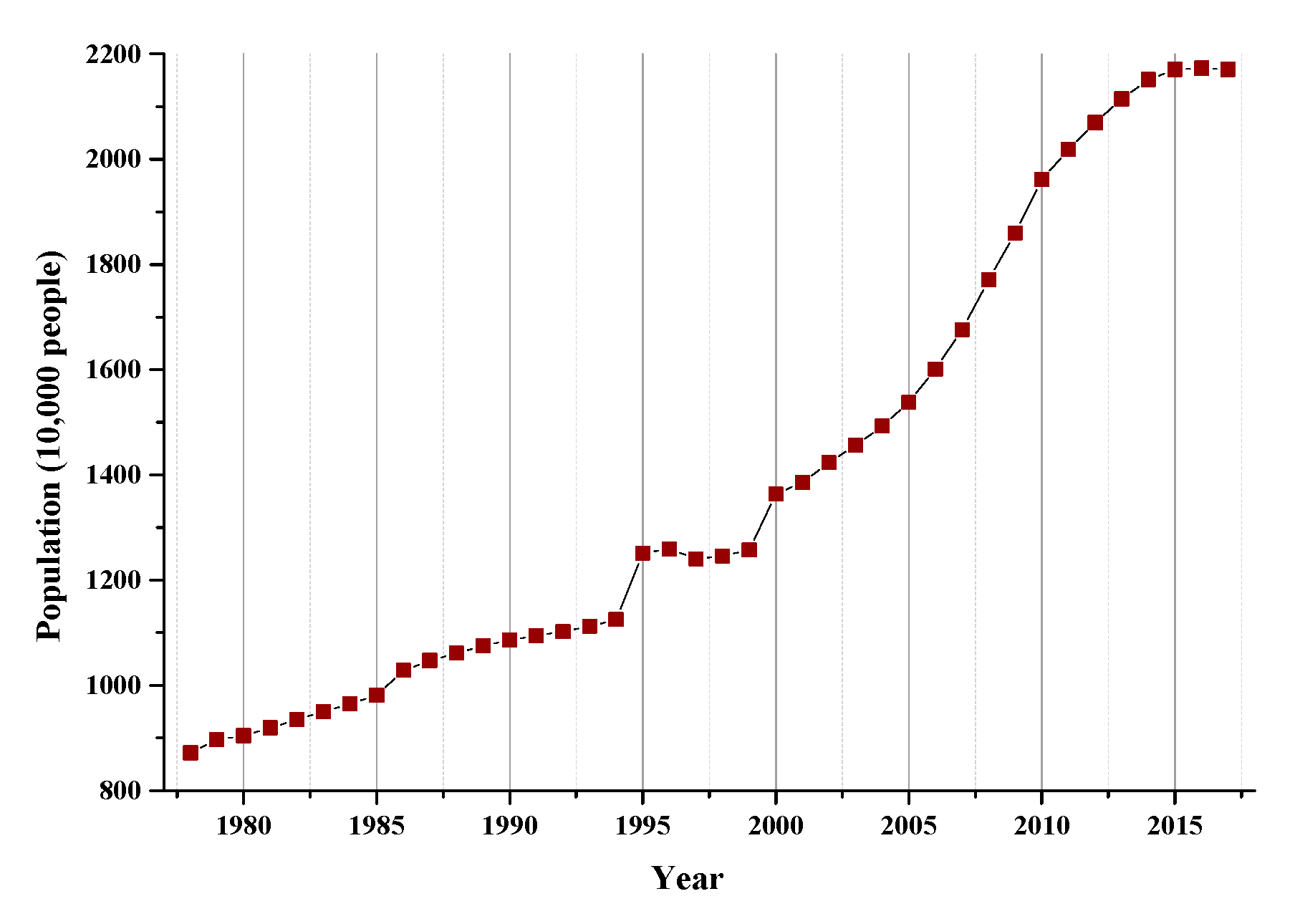
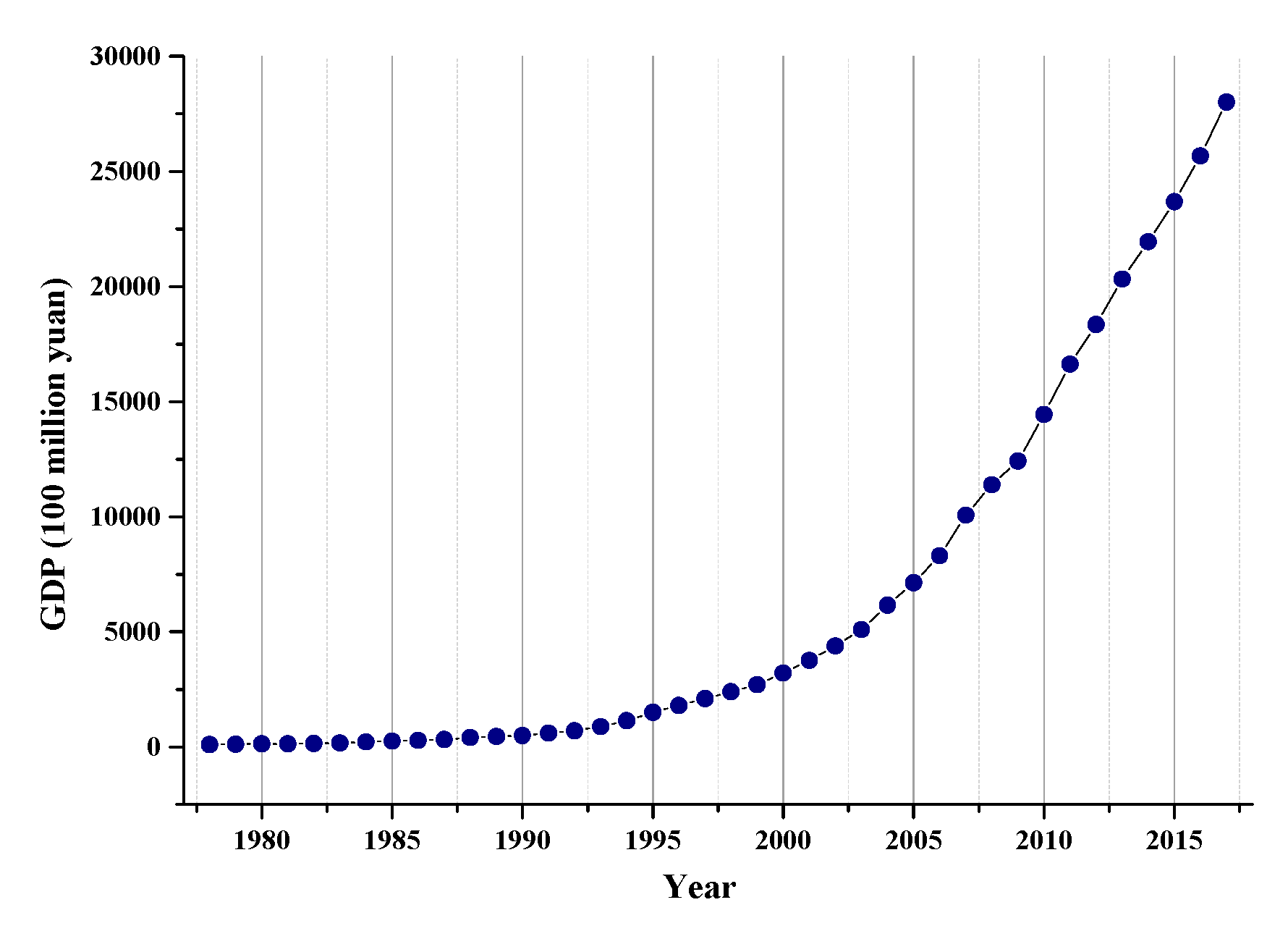







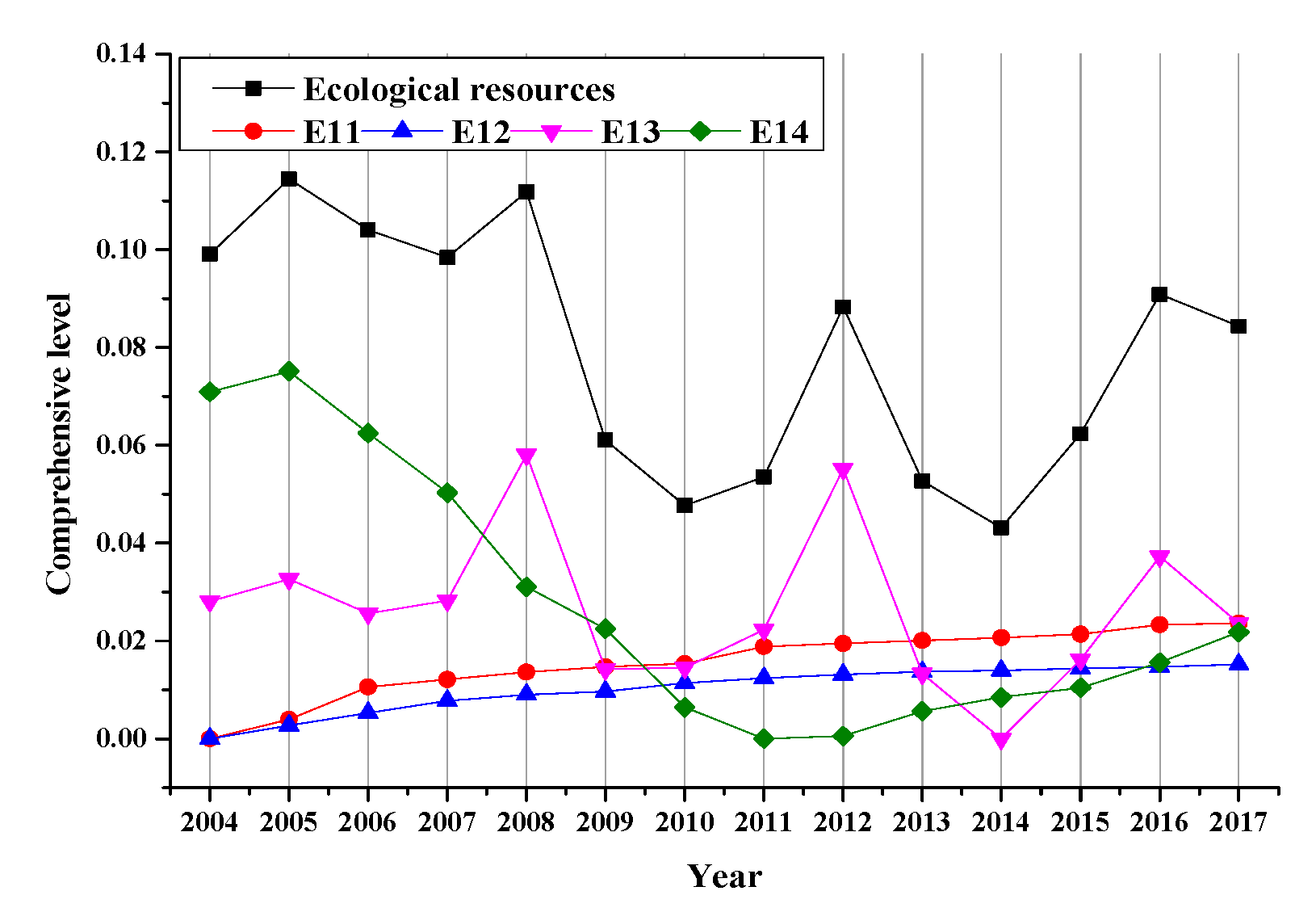


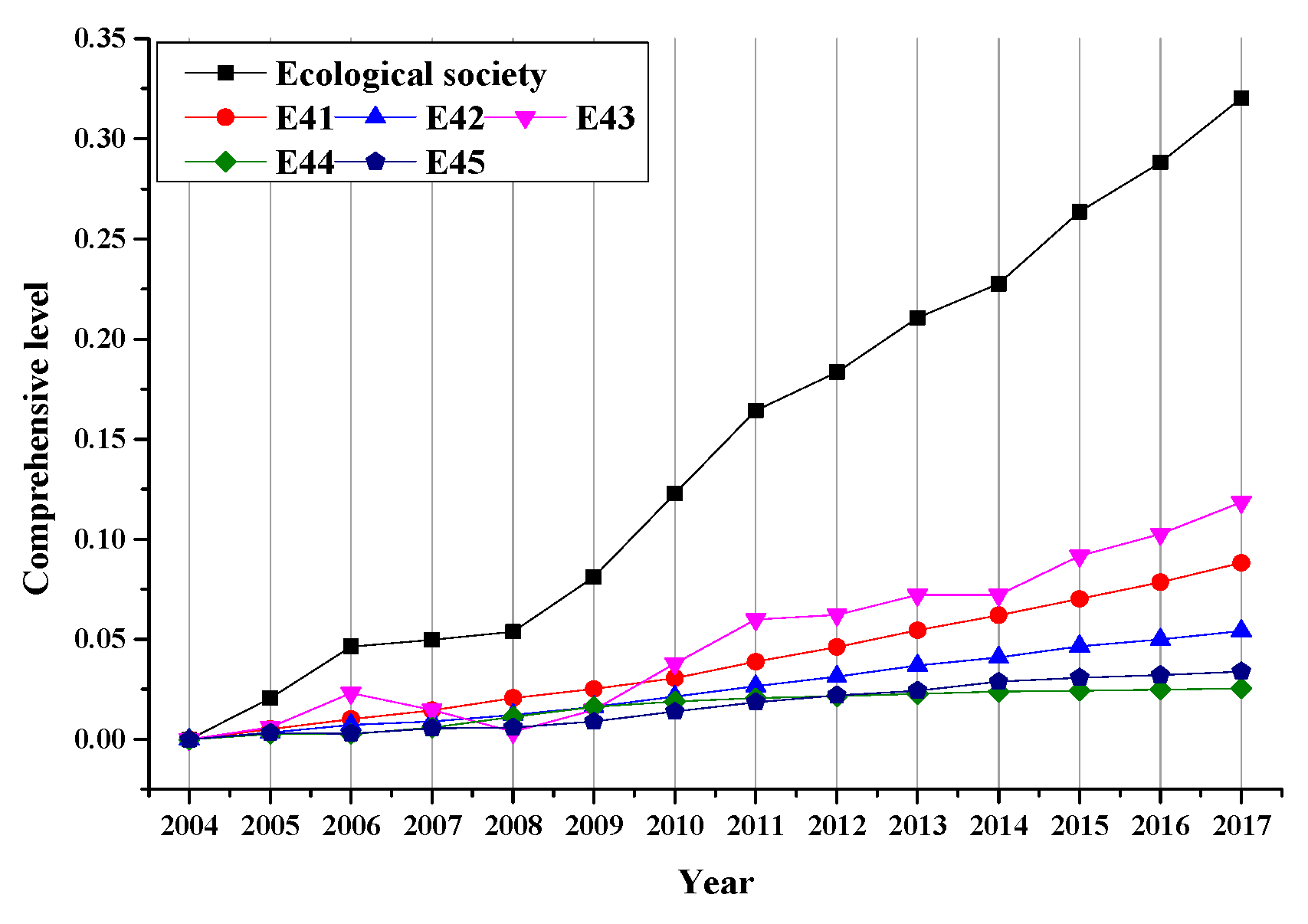
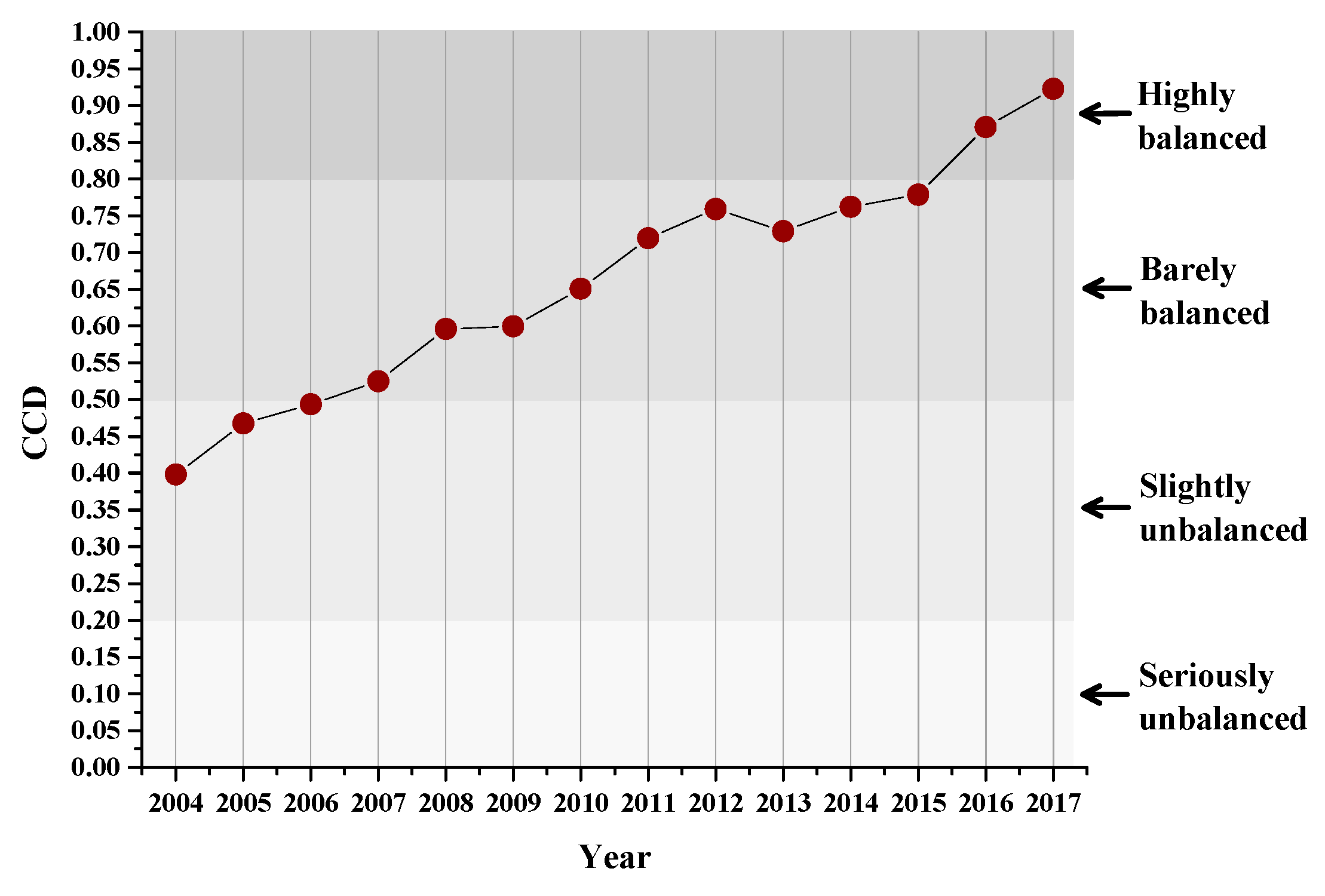
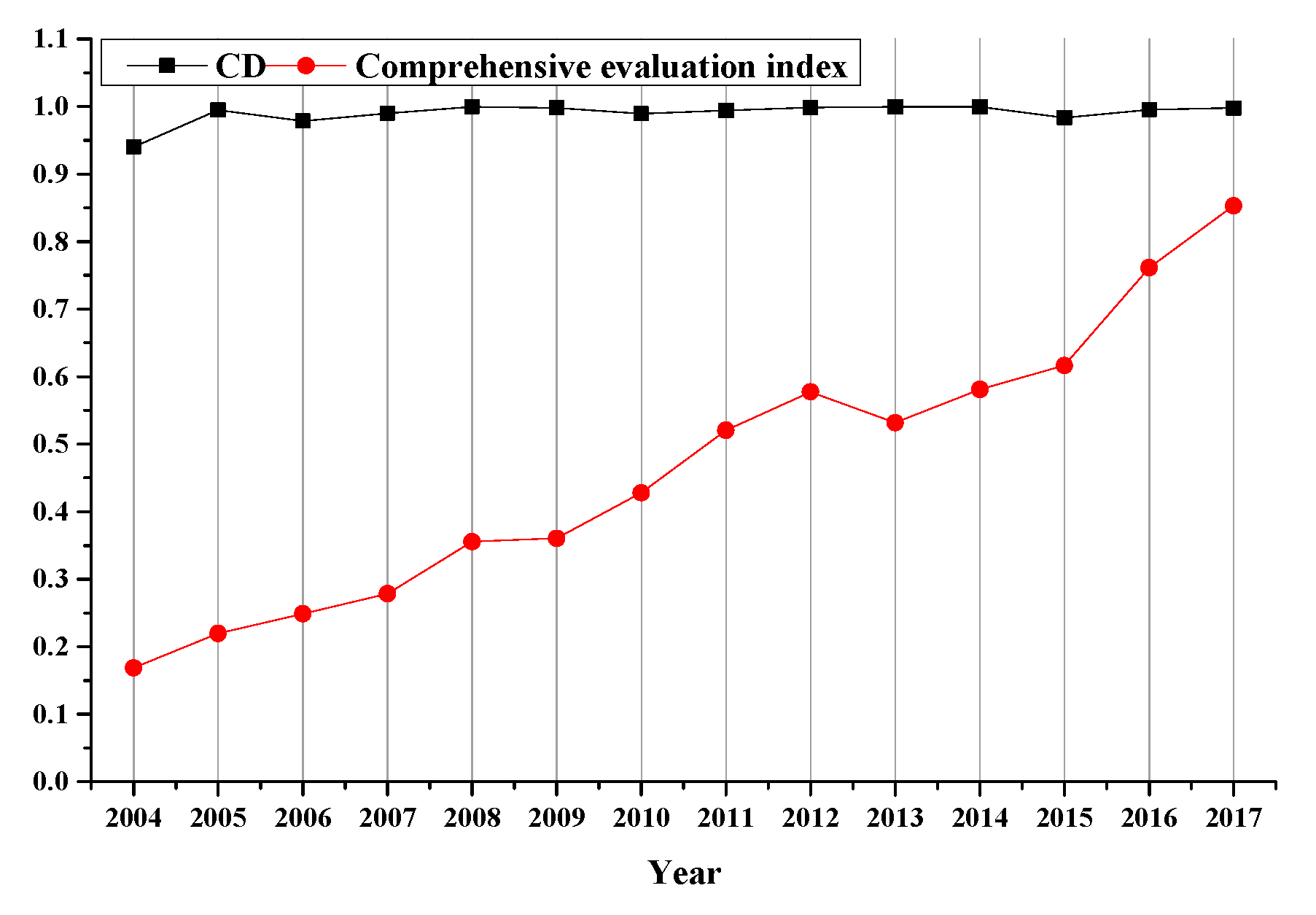
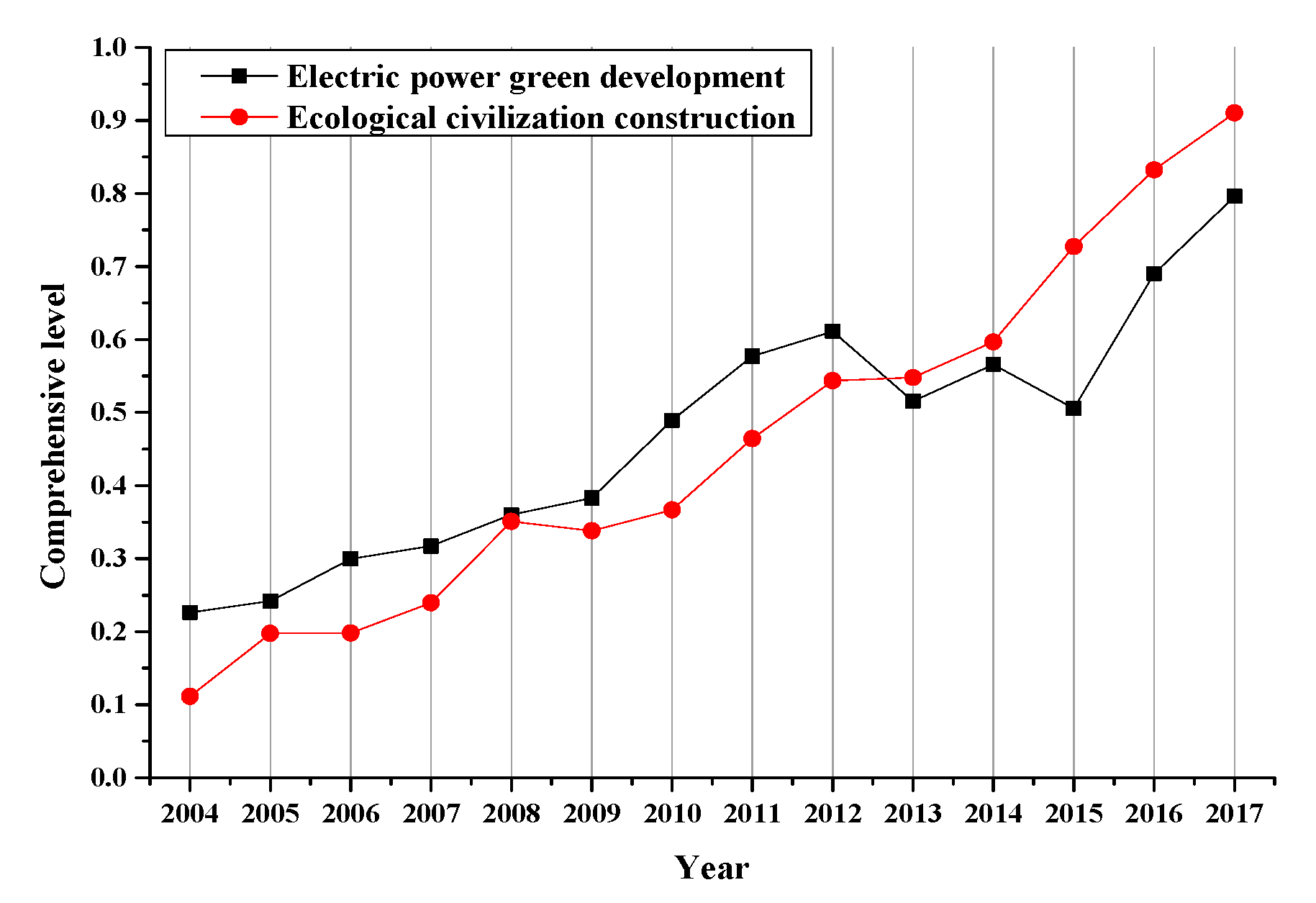

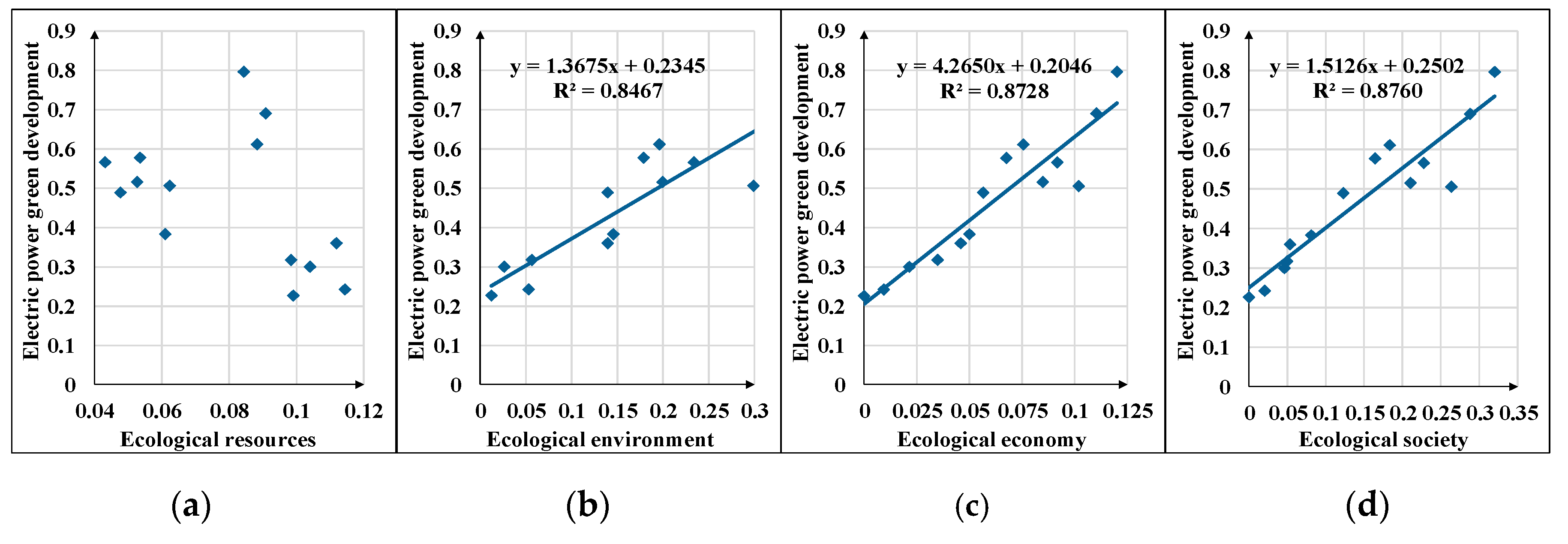
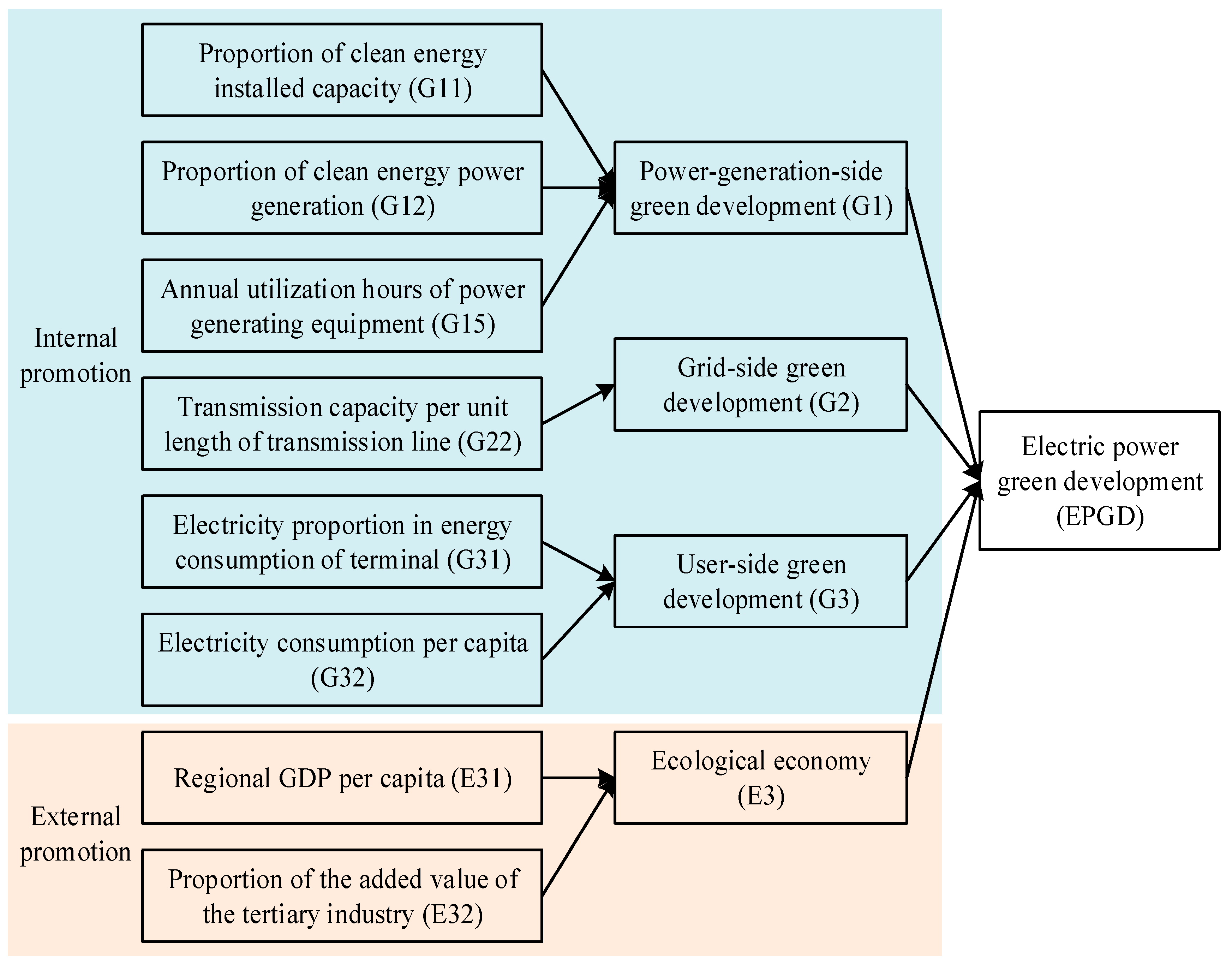
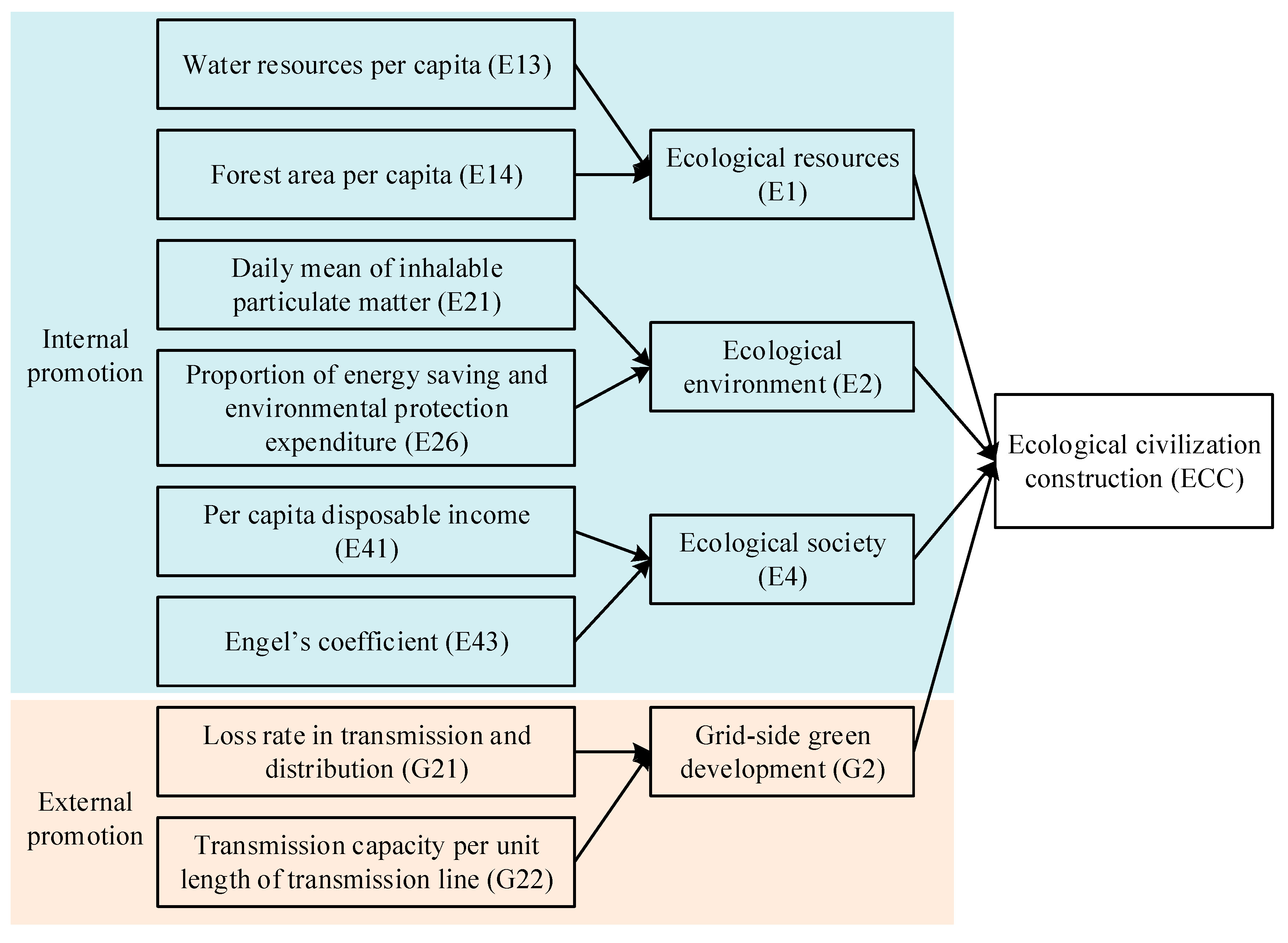
| Target | First-Grade Indices | Second-Grade Indices | Direction | Unit |
|---|---|---|---|---|
| EPGD | G1 Power-generation-side green development | G11 Proportion of clean energy installed capacity | + | % |
| G12 Proportion of clean energy power generation | + | % | ||
| G13 Proportion of external power received | + | % | ||
| G14 Standard coal consumption for power supply | − | g/kWh | ||
| G15 Annual utilization hours of power generating equipment | + | hour | ||
| G2 Grid-side green development | G21 Loss rate in transmission and distribution | − | % | |
| G22 Transmission capacity per unit length of transmission line | + | 100 million kWh/km | ||
| G23 Proportion of underground power lines | + | % | ||
| G3 User-side green development | G31 Electricity proportion in energy consumption of terminal | + | % | |
| G32 Electricity consumption per capita | + | kWh | ||
| G33 Electricity consumption per regional GDP of primary industry | − | 10,000 kWh/100 million yuan | ||
| G34 Electricity consumption per regional GDP of secondary industry | − | 10,000 kWh/100 million yuan | ||
| G35 Electricity consumption per regional GDP of tertiary industry | − | 10,000 kWh/100 million yuan | ||
| ECC | E1 Ecological resources | E11 Energy Consumption per 10,000 Yuan of regional GDP | − | ton of standard coal equivalent (SCE)/10,000 yuan |
| E12 Water Consumption per 10,000 Yuan of regional GDP | − | m3/10,000 yuan | ||
| E13 Water resources per capita | + | m3/people | ||
| E14 Forest area per capita | + | 10,000m2/people | ||
| E2 Ecological environment | E21 Daily mean of inhalable particulate matter | − | microgram/m3 | |
| E22 Daily mean of SO2 | − | microgram/m3 | ||
| E23 Daily mean of NO2 | − | microgram/m3 | ||
| E24 Chemical oxygen demand (COD) emissions | − | 10,000 tons | ||
| E25 Production of industrial solid waste | − | 10,000 tons | ||
| E26 Proportion of energy saving and environmental protection expenditure | + | % | ||
| E3 Ecological economy | E31 Regional GDP per capita | + | yuan | |
| E32 Proportion of the added value of the tertiary industry | + | % | ||
| E33 Productivity of social labor in the primary industry | + | yuan/people | ||
| E34 Productivity of social labor in the secondary industry | + | yuan/people | ||
| E35 Productivity of social labor in the tertiary industry | + | yuan/people | ||
| E4 Ecological society | E41 Per capita disposable income | + | yuan | |
| E42 Per capita consumption expenditure | + | yuan | ||
| E43 Engel’s coefficient | − | % | ||
| E44 Park green area per capita | + | m2/people | ||
| E45 Life expectancy at birth | + | year |
| Importance Judgment | Cloud Model Scale |
|---|---|
| Equally important | (1, 0.437, 0.073) |
| A little important | (3, 0.437, 0.073) |
| Generally important | (5, 0.437, 0.073) |
| Very important | (7, 0.437, 0.073) |
| Extremely important | (9, 0.437, 0.073) |
| The intermediate value of the above adjacent judgment ( = 2,4,6,8) | (, 0.707, 0.118) |
| Order | 1 | 2 | 3 | 4 | 5 | 6 | 7 | 8 | 9 | 10 |
|---|---|---|---|---|---|---|---|---|---|---|
| 0 | 0 | 0.58 | 0.9 | 1.12 | 1.24 | 1.32 | 1.41 | 1.45 | 1.49 |
| Development Stages | Types | Meaning | |
|---|---|---|---|
| Highly balanced | is lagging | ||
| synchronous development of and | |||
| is lagging | |||
| Barely balanced | is lagging | ||
| synchronous development of and | |||
| is lagging | |||
| Slightly unbalanced | is lagging | ||
| synchronous development of and | |||
| is lagging | |||
| Seriously unbalanced | is lagging | ||
| synchronous development of and | |||
| is lagging |
| Sub-Indicators | Sub-Indicators | ||
|---|---|---|---|
| G1 | (0.4490, 0.4415, 0.4408) | G2 | (0.1863, 0.1810, 0.1824) |
| G3 | (0.3647, 0.3775, 0.3768) | G11 | (0.1400, 0.1377, 0.1378) |
| G12 | (0.1565, 0.1526, 0.1524) | G13 | (0.0359, 0.0359, 0.0354) |
| G14 | (0.0821, 0.0805, 0.0809) | G15 | (0.0346, 0.0348, 0.0344) |
| G21 | (0.0616, 0.0624, 0.0628) | G22 | (0.0971, 0.0916, 0.0923) |
| G23 | (0.0276, 0.0270, 0.0274) | G31 | (0.1400, 0.1374, 0.1376) |
| G32 | (0.0856, 0.0897, 0.0898) | G33 | (0.0384, 0.0415, 0.0412) |
| G34 | (0.0414, 0.0446, 0.0442) | G35 | (0.0592, 0.0644, 0.0640) |
| Sub-Indicators | Sub-Indicators | ||
|---|---|---|---|
| E1 | (0.1721, 0.1747, 0.1748) | E2 | (0.3856, 0.3780, 0.3778) |
| E3 | (0.1220, 0.1233, 0.1233) | E4 | (0.3203, 0.3241, 0.3241) |
| E11 | (0.0237, 0.0231, 0.0234) | E12 | (0.0152, 0.0158, 0.0157) |
| E13 | (0.0581, 0.0602, 0.0603) | E14 | (0.0751, 0.0757, 0.0754) |
| E21 | (0.0787, 0.0783, 0.0782) | E22 | (0.0597, 0.0602, 0.0602) |
| E23 | (0.0518, 0.0533, 0.0532) | E24 | (0.0316, 0.0309, 0.0309) |
| E25 | (0.0283, 0.0287, 0.0283) | E26 | (0.1354, 0.1265, 0.1270) |
| E31 | (0.0514, 0.0473, 0.0479) | E32 | (0.0384, 0.0422, 0.0410) |
| E33 | (0.0060, 0.0062, 0.0063) | E34 | (0.0105, 0.0113, 0.0114) |
| E35 | (0.0158, 0.0164, 0.0167) | E41 | (0.0882, 0.0907, 0.0905) |
| E42 | (0.0542, 0.0560, 0.0562) | E43 | (0.1185, 0.1168, 0.1169) |
| E44 | (0.0255, 0.0259, 0.0258) | E45 | (0.0339, 0.0346, 0.0346) |
Publisher’s Note: MDPI stays neutral with regard to jurisdictional claims in published maps and institutional affiliations. |
© 2020 by the authors. Licensee MDPI, Basel, Switzerland. This article is an open access article distributed under the terms and conditions of the Creative Commons Attribution (CC BY) license (http://creativecommons.org/licenses/by/4.0/).
Share and Cite
Chai, J.; Zhang, L.; Yang, M.; Nie, Q.; Nie, L. Investigation on the Coupling Coordination Relationship between Electric Power Green Development and Ecological Civilization Construction in China: A Case Study of Beijing. Sustainability 2020, 12, 8845. https://doi.org/10.3390/su12218845
Chai J, Zhang L, Yang M, Nie Q, Nie L. Investigation on the Coupling Coordination Relationship between Electric Power Green Development and Ecological Civilization Construction in China: A Case Study of Beijing. Sustainability. 2020; 12(21):8845. https://doi.org/10.3390/su12218845
Chicago/Turabian StyleChai, Jianxue, Lihui Zhang, Meng Yang, Qingyun Nie, and Lei Nie. 2020. "Investigation on the Coupling Coordination Relationship between Electric Power Green Development and Ecological Civilization Construction in China: A Case Study of Beijing" Sustainability 12, no. 21: 8845. https://doi.org/10.3390/su12218845






